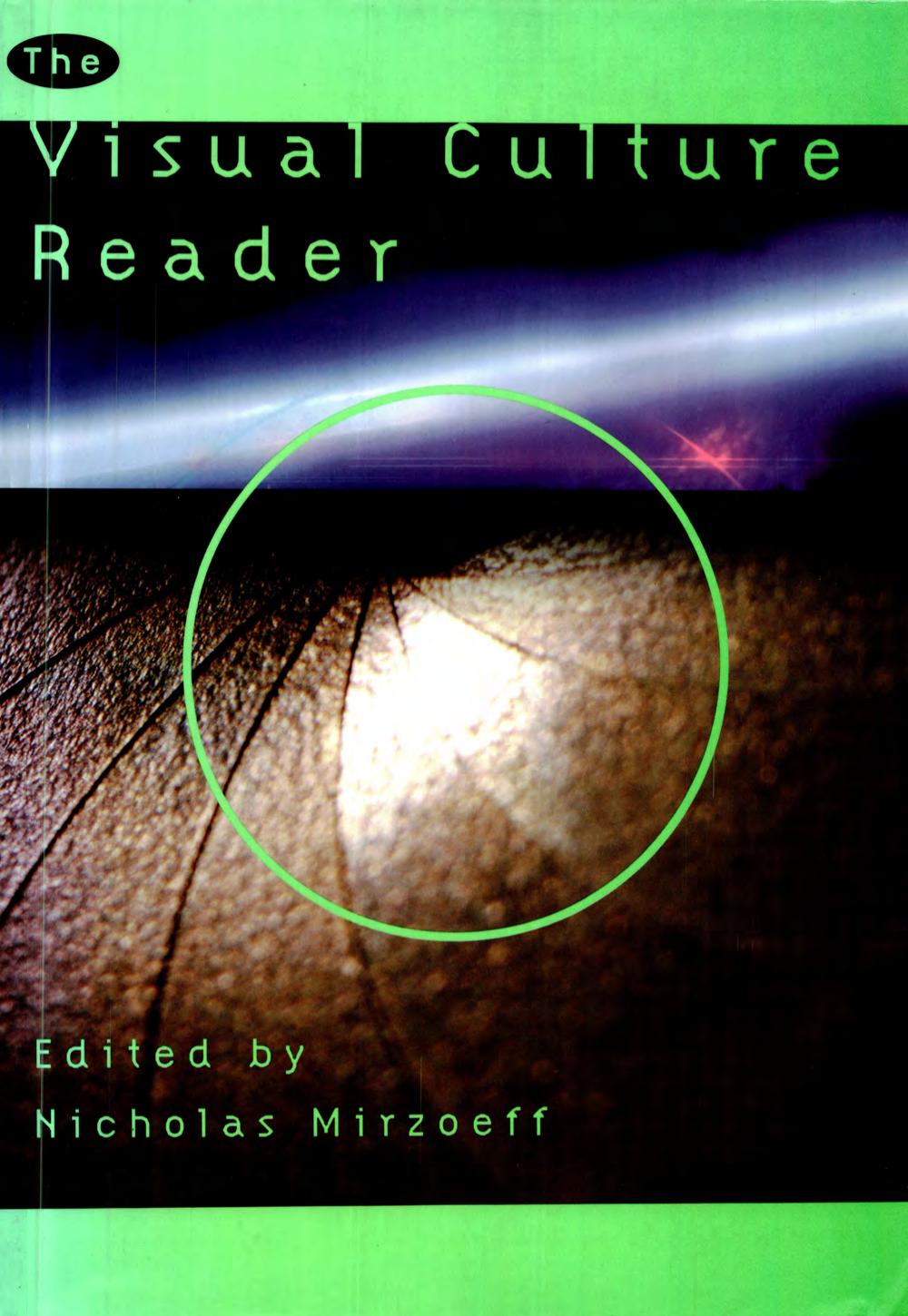Nicholas Mirzoeff (ed.): The Visual Culture Reader (1998–)
Filed under book | Tags: · art history, digital cinema, feminism, popular culture, postmodernism, telepresence, virtual reality, visual culture

“The Visual Culture Reader brings together key writings as well as specially commissioned articles covering a wealth of visual forms including photography, painting, sculpture, fashion, advertising, television, cinema and digital culture. The Reader features an introductory section tracing the development of visual culture studies in response to globalization and digital culture, and articles grouped into thematic sections, each prefaced by an introduction by the editor and conclude with suggestions for further reading.”
Publisher Routledge, London & New York, 1998
ISBN 0415141346, 9780415141345
xvi+530 pages
Second edition, revised
Publisher Routledge, 2002
ISBN 0415252229, 9780415252225
xix+737 pages
Publisher (3rd ed.)
PDF (1st ed., 12 MB; added on 2021-3-11)
PDF (2nd ed., 35 MB, no OCR, some pages missing, updated on 2012-7-18)
Daniel Barnett: Movement as Meaning: In Experimental Film (2008)
Filed under book | Tags: · cinema, digital cinema, experimental film

This book offers sweeping and cogent arguments as to why analytic philosophers should take experimental cinema seriously as a medium for illuminating mechanisms of meaning in language. Using the analogy of the movie projector, Barnett deconstructs all communication acts into functions of interval, repetition and context. He describes how Wittgenstein’s concepts of “family resemblance and language games” provide a dynamic perspective on the analysis of acts of reference. He then develops a hyper-simplified formula of “movement as meaning” to discuss, with true equivalence, the process of reference as it occurs in natural language, technical language, poetic language, painting, photography, music, and of course, cinema. Barnett then applies his analytic technique to an original perspective on cine-poetics based on Paul Valery’s concept of omnivalence, and to a projection of how this style of analysis, derived from analog cinema, can help us clarify our view of the digital mediasphere and its relation to consciousness. Informed by the philosophy of Quine, Dennett, Merleau-Ponty as well as the later work of Wittgenstein, among others, he uses the film work of Stan Brakhage, Tony Conrad, A.K. Dewdney, Nathaniel Dorsky, Ken Jacobs, Owen Land, Saul Levine, Gregory Markopoulos Michael Snow, and the poetry of Basho, John Cage, John Cayley and Paul Valery to illustrate the power of his unique perspective on meaning.
Key words and phrases
language game, phi phenomenon, Maltese cross, Otto Muehl, Saul Levine, Kinesics, haiku, optical printer, Cross Movement, meme, movie projector, Ken Jacobs, mesostic, digital cinema, polyvalence, Bolex, ontological, P-frame, persistence of vision, George Landow
Publisher Rodopi, 2008
ISBN 9042023856, 9789042023857
Length 240 pages
More info (publisher)
More info (google books)
Sean Cubitt: The Cinema Effect (2004)
Filed under book | Tags: · cinema, digital cinema, film, film history, film theory, image, post-cinema

“It has been said that all cinema is a special effect. In this highly original examination of time in film Sean Cubitt tries to get at the root of the uncanny effect produced by images and sounds that don’t quite align with reality. What is it that cinema does? Cubitt proposes a history of images in motion from a digital perspective, for a digital audience.
From the viewpoint of art history, an image is discrete, still. How can a moving image–constructed from countless constituent images–even be considered an image? And where in time is an image in motion located? Cubitt traces the complementary histories of two forms of the image/motion relationship–the stillness of the image combined with the motion of the body (exemplified by what Cubitt calls the “protocinema of railway travel”) and the movement of the image combined with the stillness of the body (exemplified by melodrama and the magic lantern). He argues that the magic of cinema arises from the intertwining relations between different kinds of movement, different kinds of time, and different kinds of space.
He begins with a discussion of “pioneer cinema,” focusing on the contributions of French cinematic pioneers in the late nineteenth and early twentieth centuries. He then examines the sound cinema of the 1930s, examining film effects in works by Eisenstein, Jean Renoir, and Hollywood’s RKO studio. Finally he considers what he calls “post cinema,” examining the postwar development of the “spatialization” of time through slow motion, freeze-frame, and steadi-cam techniques. Students of film will find Cubitt’s analyses of noncanonical films like Sam Peckinpah’s Pat Garrett and Billy the Kid as enlightening as his fresh takes on such classics as Renoir’s Rules of the Game.”
Publisher MIT Press, 2004
ISBN 0262033127, 9780262033121
456 pages
PDF (updated on 2021-1-29)
Comment (0)
